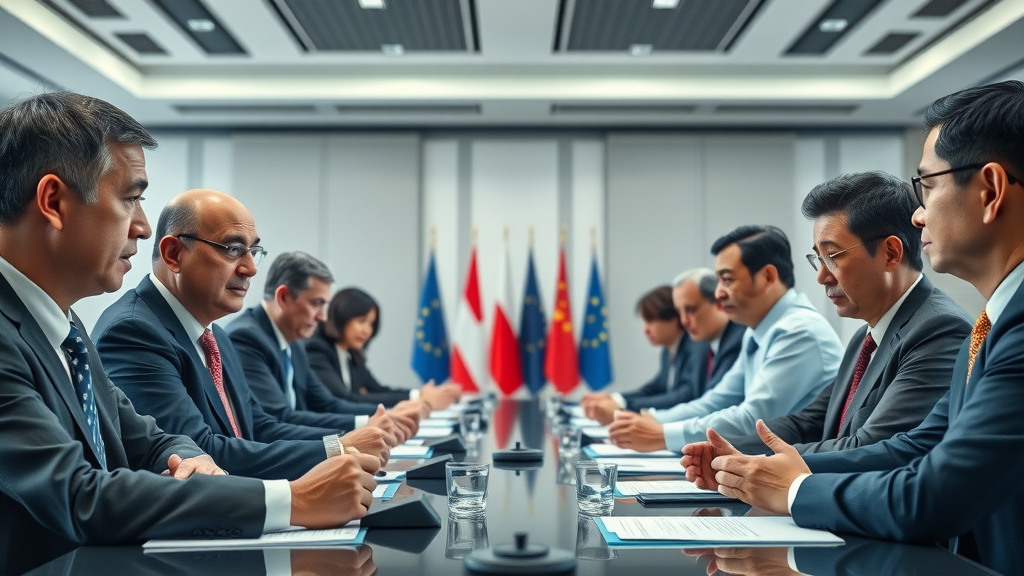"Tariffs imposed during trade wars can erase up to 30% of a business's annual profits if left unchecked. Yet, strategic planning can transform risks into opportunities."
Understanding Trade War Tariffs and Their Impact
Trade war tariffs have redefined the landscape of global trade and reshaped how modern businesses protect their profits. When governments like the United States or China impose steep tariffs, the effects cascade through supply chains , manufacturing, and even consumer pricing worldwide. The aim often goes beyond raising revenue—it’s about shifting the balance of power in international trade . During turbulent times, such as the high-stakes battles waged between the Trump administration and China, businesses face a critical question: How do you prevent tariffs from draining away your hard-earned revenue?
To answer this, it’s crucial to first grasp the core mechanics of trade war tariffs . These government-imposed fees on foreign goods are designed to protect domestic industries or punish trading partners, but the resulting retaliatory tariffs and policy changes can catch even the most seasoned business off guard. The White House has wielded tariffs as both shield and sword, defending U.S. interests while sometimes deepening trade deficits or sparking inflation. For any business with global reach—or even just one vulnerable supplier overseas—understanding these shifts can make the difference between profit and peril.

| Year | United States Tariffs on Chinese Goods | China's Tariffs on U.S. Goods |
|---|---|---|
| 2018 | 25% on $50B imports (tech, automotive, aerospace) | 25% on $50B imports (soybeans, autos, seafood) |
| 2019 | 15-25% on $350B additional imports | 5-25% on $185B additional imports |
| 2020 | Phase One Deal (partial tariff reductions) | Reductions on specific U.S. goods, ongoing retaliatory tariffs |
| 2021–2024 | Selective tariff relief, new sectors targeted | Ongoing countermeasures, targeted U.S. sectors |
What This Article Will Reveal About Trade War Tariffs
- How trade war tariffs reshape international trade and business strategies
- Insights from the Trump administration and White House decisions
- Practical steps for protecting profits amid global trade volatility
- Lessons from the United States–China trade war and imports from China
- Data-driven perspectives on supply chains and retaliatory tariffs
Trade War Tariffs: A Historical Perspective on Global Trade
Trade war tariffs are not a novel phenomenon—history is dotted with landmark moments when nations wielded tariffs as economic weapons. One of the most infamous examples is the Smoot-Hawley Tariff Act of 1930 , which imposed steep import duties on hundreds of foreign goods . This move, intended to shield U.S. farmers and businesses during the Great Depression, instead backfired, triggering a global protectionist spiral that shrank international trade by two-thirds and deepened the economic crisis.
Fast forward, and similar chapters played out with steel and aluminum tariffs in the 21st century, as well as retaliatory tariffs from trading partners like the European Union and China. The cyclical nature of these events shows that while the actors and products may change, the core dynamics remain: economic nationalism leads to tit-for-tat measures, putting both domestic industries and global supply chains at risk.

Landmark Trade Wars in International Trade History
- The Smoot-Hawley Tariff Act of 1930: Triggered a global trade collapse and retaliatory tariffs worldwide.
- Recent steel and aluminum tariffs: Sparked major responses from the European Union and China.
- Retaliatory tariffs: The cycle of action and reaction by leading economies shapes today’s trade policy landscape.
How the United States Influenced Global Trade Policy
The United States has long been an architect of global trade rules, wielding its economic might to shape the trajectory of international trade . From creating postwar trade organizations to setting trade policy under various administrations, America’s decisions have rippled across continents. In the case of recent trade war tariffs , the White House applied unprecedented tariff rates on key products, testing old alliances and triggering retaliatory actions that challenged longstanding partnerships.
Recent history—particularly actions under the Trump administration —illustrates how one nation's tariff decisions can dramatically reshape not just bilateral ties, but the broader rhythm of global commerce. These policy shifts underline a central lesson: staying attuned to changes in national trade policy is indispensable for businesses that depend on open supply chains and reliable international partnerships.

How Do Trade War Tariffs Affect Imports from China?
The impact of trade war tariffs on imports from China has been profound, jolting everything from product pricing to supply chain stability. The intense tariff confrontations that began under the Trump administration led to dramatic cost increases for thousands of Chinese goods entering U.S. markets. These actions were intended to address the bilateral trade deficit , protect U.S. intellectual property, and pressure China into reforming practices viewed as unfair or coercive.
For businesses reliant on Chinese imports —from consumer electronics to raw materials—the imposition of tariffs often meant absorbing significant cost increases or passing those costs on to consumers, further fueling inflation. Many companies hurried to find alternative suppliers or reengineer products to minimize reliance on imports from China , sparking a major phase of global supply chain restructuring.
The China Trade and the Trump Administration's Tariff Policy
The Trump administration fundamentally shifted U.S.–China trade relations by moving away from conventional trade deal negotiations and instead embracing aggressive tariffs. These measures included levies of up to 25% on hundreds of billions in Chinese goods —from agricultural products and electronics to machinery and textiles. The official reasoning was not only economic: the White House cited national security concerns alongside the more familiar themes of trade imbalances and unfair practices.
This approach marked a major break with previous strategies, igniting a chain reaction of retaliatory tariffs from China and other trading partners. U.S. businesses, used to relatively smooth international trade , suddenly had to contend with shifting tariff rates , customs rules, and a far more unpredictable trading environment.
Key Impact Areas: Supply Chain Disruptions and National Security
Among the most significant consequences of the U.S.–China trade war were direct supply chain disruptions. Many U.S. businesses found their entire sourcing strategies upended as tariffs inflated costs and reduced reliability. For industries like technology and manufacturing, where imports from China supply key components, the challenge was especially acute.
National security was frequently cited as a justification for the new tariffs, with concerns ranging from technology transfer risks to control over rare earth materials. The intertwining of national security and trade gave these tariffs a unique urgency, forcing companies to not only chase lower costs but also mitigate geopolitical risks that had suddenly become paramount.
"The Trump admin’s aggressive stance on imports from China triggered a domino effect, reshaping supply chains and raising questions about national security."
Trade Deal Negotiations: What We Learned from the Trump Admin & White House
The years of tough trade war tariffs exposed sharp divides in approach during U.S.–China trade negotiations. Rather than pursuing incremental trade deals through established diplomatic channels, the Trump administration leveraged tariffs both as bargaining chips and as blunt instruments to force rapid change. This negotiation style was characterized by unpredictable moves, last-minute reversals, and a reliance on escalating costs to win concessions. While this strategy led to certain short-term agreements—like the Phase One deal in 2020—it also heightened long-term risks for businesses across both countries.
Why the Trump Administration Chose Tariffs Over Trade Agreements
The drive to impose tariffs over breakneck trade deal diplomacy reflected a belief within the White House that previous approaches had failed to deliver the desired results for U.S. industry and workers. With concerns about trade deficits , lost jobs, and intellectual property theft at the forefront, the administration turned to high-impact tariffs to force negotiations onto American terms. This approach upended years of precedent in global trade policy. While controversial, it did succeed in moving China to the negotiating table—but at the expense of increased volatility for businesses operating across borders.

The Role of President Trump in Changing China Trade Dynamics
- Pressure tactics and retaliatory tariffs: The White House favored direct, high-profile pressure to drive negotiations and extract concessions from China, leading to a cycle of tariff hikes and countermeasures.
- Communication breakdown and its effects: Volatility in talks led to uncertainty for global firms as plans changed quickly and firm agreements were elusive.
- Impacts on global trade partnerships: The unpredictability of the process tested alliances with other major economies and shifted the global trade landscape.
"President Donald Trump’s decision to impose steel and aluminum tariffs marked a turning point in international trade."
Protecting Your Profits During a Trade War Tariff Crisis
For businesses, managing trade war tariffs is now an essential survival skill. The volatility unleashed by shifting trade policy , retaliatory tariffs, and global uncertainties means the cost of inaction can be catastrophic—potentially slashing profits by a third or more. But while risk is high, so too are the opportunities for those who plan and adapt faster than their competitors.
Companies that proactively strengthen their supply chain resilience, stay ahead of evolving trade policy , and explore new markets or products are much better positioned to weather the storm. This is not just about avoiding loss; it's about leveraging adversity to carve out new niches, develop innovative products, or find cost savings that endure even after tariff policies shift.
Risk Mitigation Strategies for Global Trade Uncertainty

- Diversify suppliers beyond China: Build relationships with multiple vendors in different regions to spread risk.
- Monitor trade policy changes from the White House: Stay alert to policy shocks that could affect costs and logistics.
- Implement dynamic pricing strategies: Adjust pricing to offset unexpected tariff costs and protect profit margins.
- Invest in customs compliance and consulting: Ensure up-to-date paperwork and expert advice to avoid costly mistakes.
- Strengthen supply chain technology: Adopt advanced logistics platforms for greater agility and visibility.
Turning Tariff Challenges into Opportunities for Growth
With the right mindset, the disruption of trade war tariffs can yield unexpected advantages. Some businesses have leveraged the crisis by rolling out “Made in USA” product lines, exploring near-shoring, or adopting cutting-edge automation to reduce dependency on foreign suppliers. Others have used the attention on tariffs to renegotiate contracts, pivot to high-margin offerings, or target export markets left open by rival companies pulling back. In turbulent times, adaptability and innovation are the greatest tools at a company’s disposal. The key is to move fast, remain flexible, and turn external threats into springboards for sustainable growth.

| Industry | Profit Margin Before Tariffs | Profit Margin After Tariffs | Notable Adjustments |
|---|---|---|---|
| Manufacturing | 8-12% | 4-7% | Supplier diversification, factory automation |
| Technology | 18-22% | 13-18% | Product redesign, new distribution routes |
| Consumer Goods | 10-15% | 6-10% | Dynamic pricing, local sourcing |
Retaliatory Tariffs from China and the European Union: What U.S. Businesses Must Know
One of the biggest risks in a trade war is that no action goes unanswered. As the United States imposes tariffs, major trading partners like China and the European Union often respond in kind, targeting key U.S. industries—such as agriculture, automotive, and electronics. This escalation, known as retaliatory tariffs , quickly multiplies losses and instability for American exporters and supply chains.
For U.S. businesses seeking to remain competitive, understanding the timing and nature of these retaliatory moves is crucial. Products that escape the initial rounds of tariffs might soon find themselves under fire as alliances shift and leaders seek leverage in ongoing negotiations.
How Retaliatory Tariffs Intensify the Trade War
Retaliatory tariffs are designed to maximize economic pain on the originating country, often targeting politically sensitive sectors or regions. When China imposed tariffs on American soybeans and aircraft, or when the European Union responded with duties on U.S. motorcycles and bourbon, the political message was as clear as the bottom-line impact. This back-and-forth escalation compounds uncertainty for businesses, investors, and consumers. Navigating this environment demands constant vigilance and rapid decision-making to minimize disruption and leverage any possible opportunity.

Strategies to Prepare Your Business for Future Tariff Risks
The lesson from recent trade wars is clear: today’s winners are those who make adaptability a strategic priority. Building flexibility into every aspect of the business—from supply chains and sourcing to product development and customer relationships—is the best defense against sudden shifts.
Investing in real-time data analytics, scenario planning, and global compliance expertise empowers leaders to see around the next corner. With new policy shocks always a possibility, the companies that embrace change are more likely to thrive, even as tariff regimes wax and wane.

Frequently Asked Questions About Trade War Tariffs
What is a trade war tariff?
A trade war tariff is a tax imposed by one country on imported goods from another country during a period of economic conflict or negotiation. This measure is often used to protect domestic industries or pressure trading partners into altering their trade policies . In turn, targeted countries usually respond with retaliatory tariffs , escalating the economic standoff.
What is the meaning of trade tariffs?
Trade tariffs are government-imposed taxes on imported or exported goods. Their primary goals are to regulate trade flows, raise revenue, protect local industries, and sometimes punish or incentivize foreign trading partners. The tariff rate can vary widely and is often set by the country’s trade representative or equivalent authority.
What tariffs started the Civil War?
The series of tariffs leading up to the U.S. Civil War—most famously the Tariff of Abominations (1828) and subsequent Morrill Tariff (1861)—fueled regional tensions between industrial North and agrarian South. Southern leaders opposed these protective trade tariffs , which increased the cost of imported goods, contributing to economic grievances that fed the larger conflict.

What tariffs did Trump put on China?
President Donald Trump’s administration imposed a series of escalating tariffs on Chinese goods starting in 2018. Measures included 25% on $50 billion worth of technology and industrial imports, followed by duties of 10–25% on hundreds of billions more in consumer and manufacturing products. These tariffs were intended to address trade imbalances, protect national security, and prompt China trade reforms.
Key Insights on Navigating Trade War Tariffs for U.S. Businesses
- Proactive supply chain diversification is vital: Spread sourcing across multiple countries to reduce exposure to country-specific tariffs and disruptions.
- Regularly monitor international trade policy developments: Stay informed to anticipate tariff changes and shift strategies quickly.
- Adopt technology for smarter compliance: Use digital tools for real-time tariff calculation and regulatory tracking.
- Anticipate retaliatory tariffs and build resilience: Prepare for countermeasures from partners like China or the European Union by stress-testing business models.

The Future of Trade War Tariffs: Final Perspectives & Takeaways
"Survival in a world of fluctuating tariffs isn’t about waiting it out, but adapting—and sometimes thriving—by staying informed and responsive to international trade policy shifts."
In the face of relentless trade war tariffs and global market uncertainty, the best course for any business is to stay agile, monitor changes, diversify supply chains, and embrace technology-driven solutions.
 Add Row
Add Row  Add
Add 




Write A Comment